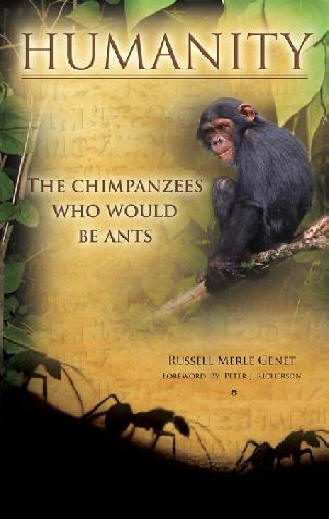 |
TABLE OF CONTENTS
FORWARD Peter J.
Richerson
PROLOGUE In a nutshell
I.
WHAT CAME BEFORE HUMANITY?
Setting the stage
1.
COSMOS
Stars and Planets for life
2.
LIFE
Nature’s road to complexity
3.
ANTS
Jewels of the genetic crown
4.
CHIMPANZEES
Masters of Machiavellian intrigue
II.
HOW DID WE COME TO BE?
Culture evolution takes command
5.
HOMINIDS
The chimpanzees who were thrown to the lions
6.
CIVILIZATIONS The
chimpanzees who became ants
7.
MACHINES
The geese who laid the golden eggs
8.
SCIENTISTS
The curious cats who pried open
Pandora's Box
III.
WHAT IS OUR FATE?
Four alternative finales
9.
CHIMPANZEE PARADISE
High-tech Garden of Eden
10.
BOOM & BUST
May the punishment fit the crime
11.
PLANETARY SUPERORGANISM
Together on the global farm
12.
STAR TREK
Our descendants inherit the galaxy
EPILOGUE Futures most likely and desirable
»
ABOUT THE AUTHOR
RUSSELL MERLE GENET
|
BOOK DESCRIPTION
Humanity: The
Chimpanzees Who Would Be Ants
is the science-based story of how, in a remote corner of an ordinary
galaxy 13.7 billion years after the Big Bang, the descendants of a third
line of chimpanzees evolved into millions of humans who organized
themselves into ant-like societies. Originally rare hunters, we humans
took up agricultural ways, aping the clever ants that became numerous by
developing ingenious herding and gardening skills. Evolving our simple
chimp tools into machines, we then tapped a bonanza of fossil fuel
energy and blitzkrieged the planet. Now facing planetary limits, what is
our fate? Reversing direction, will we return to a planetary Garden of
Eden or, pedal to the metal, crash into oblivion? Will we transform the
Earth into a sustainable global farm or, leaving our birth-planet
behind, voyage to the stars with our machine partners to establish a
galactic empire?
© 2007 |